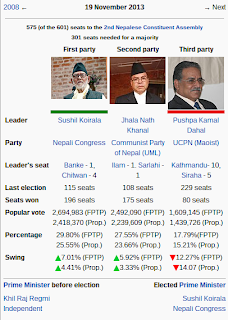| English: A sketch of Mr. Amitab Bachchan (Photo credit: Wikipedia) |
| English: Amitabh Bachchan photographed by Studio Harcourt Paris Français : Amitabh Bachchan photographié par Studio Harcourt Paris Harcourt Paris (Photo credit: Wikipedia) |
Upendra Yadav was established in Nepali politics through the first Madhesi Kranti. For him to deny the existence of Madheshvad is odd. Or plain ignorant.
What is the Madhesh? It is the land gifted by the British to the then Nepali rulers. Otherwise the current Madhesh would have been part of India.
Who are the Madhesis? The Madhesis are the Indian origin people living in the Madhesh. It is a cultural, and not a geographical term. Because, by now, almost 40% of the Teraiwasis are Pahadi. Pahadi is also a cultural term. That includes those who speak Nepali as their first language. That also denotes the Janajatis from the Hills who are now settled in the Terai. The Madhesis speak Maithili (my first language), Bhojpuri, Awadhi (Amitabh Bachchan's first language), Tharu, Urdu, Hindi, Marwadi and so on. The Tharus are very much Madhesi in terms of similarities in language, culture, traditions, and political marginalization. As are the Muslims in the Terai. They are Madhesi.
What is Madheshvad? Madhesvad is the name of the political struggle that hopes to give proportionate representation to the Madhesis in the Nepali state structure. Once that goal is achieved, Madhesvad will linger on as a cultural term. It will mean enriching the Madhesi cultures. Lakhs of Madhesis have been denied citizenship cards. Making sure they get those cards is the most important goal of Madheshvad. The second most important goal is federalism. No to North-South states. Yes to East-West states. No to adding Kailali, Kanchanpur, Jhapa and Morang to the hill states. Yes to keeping all Terai districts in the Terai states. Yes to eliminating some national level ministries. Yes to downsizing the Nepal Army, which is basically a Pahadi Army. Yes to reservations for Madhesis. Yes to Madhesi police forces in the Madhesi states.
So, yes, Madhesvad does exist. That Upendra Yadav says it doesn't shows he was just surfing the wave in 2007. He did not create it.
But Madheshvad is also to do with economic development. Actually, I'd like to argue Madheshvad as an ideology is primarily to do with development. The Hulaki Rajmarg is the backbone of the Madheshvad. Taking the per capita income among Madhesis to global levels is the most important, and the ultimate goal of Madheshvad.









